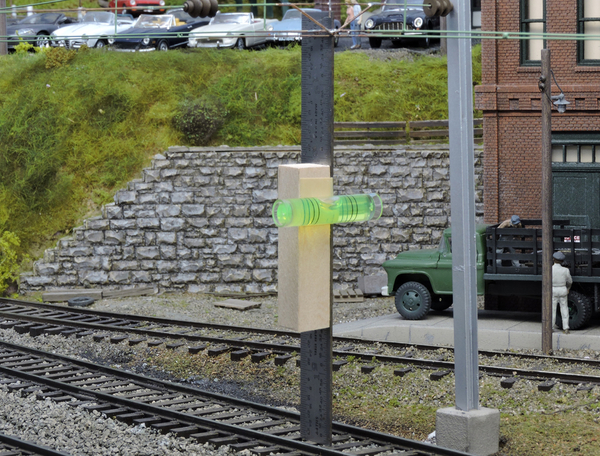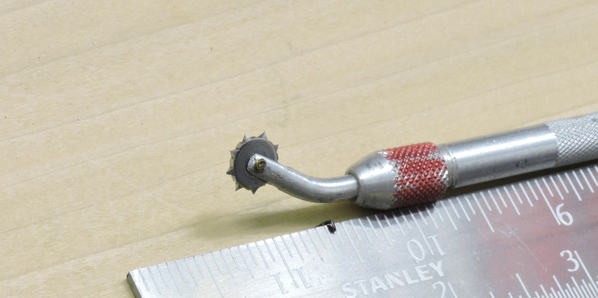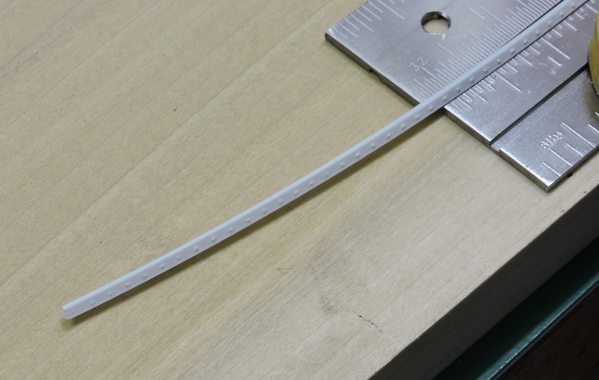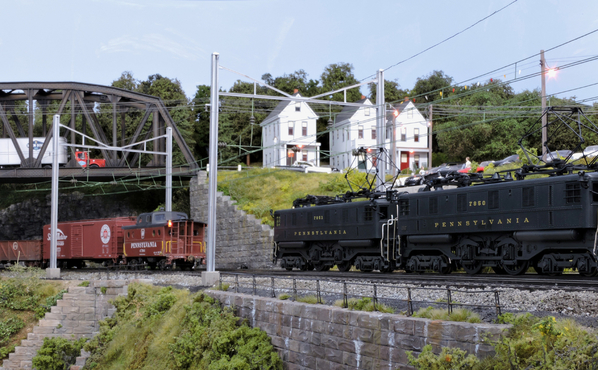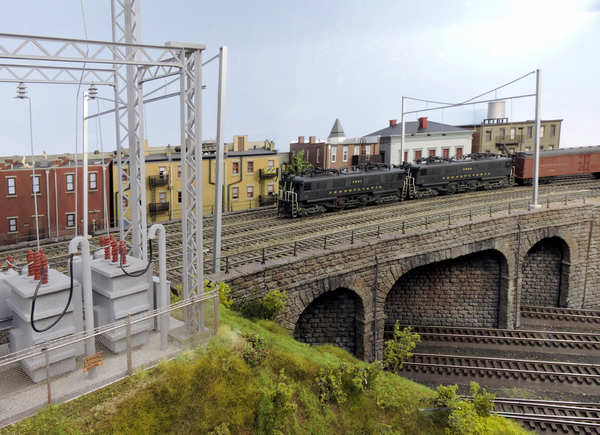I am sure I am not the only DC area O scaler spending their summer preparing their layout for the upcoming O Scale National in Rockville, MD
In my case, "preparing my layout" meant getting some catenary up. I am modeling the electrified main line through New Jersey in 1956. so its tough to justify not having it. I won’t get as far as I would have liked by the time of the convention (As they say, “Life got in the way”), but I have completed one 20 ft double tracked section:
The K-Bridge poles are made of brass, and built to my width specifications by Model Memories,
Don Silbauer, the owner, is very easy to work with
I added the angle corner braces, the signal wires, the rain caps, and made the bases look more like poured concrete than folded brass
I soldered together the catenary from 36” long lengths of .025” diameter Phosphor Bronze wire from the Tichy Train Group. Steady wires and cross wires are made of the same material. The insulators come from Model Memories, as well as a stash I got from Ed Duddy many years ago.
Before going further, I owe a huge debt to Andy Rubbo. He wrote a very comprehensive and detailed series of articles in the Winter 1996 Keystone Modeler on how he built PRR catenary for his HO layout. Andy supplements his writing with a lot of photos, and even assembled some components on the bench just for photographs for the article. (You can’t get this online, but you can get it in the Keystone Modeler CD-ROM No. 5, sold through the PRR society’s website, www.prrths.com.) Andy has also been to my layout and offered even more tips. He is very generous with his advice. And more importantly, he knows what he is talking about. THANKS ANDY!
I also want to thank Rick Wright, fellow Burke O Scaler, who, during several of our pre York Rail fan expeditions took lots of photos of catenary construction. Here is an example of his potential Pulitzer Prize winning work:
Finally, I’d like to thank my back, for holding up during several hour-long sessions of stringing catenary wire with both hands.
One of the issues I faced is my sub roadbed is 1” pink foam sitting on ¾” thick plywood. This is great for scenery, as it readily allows below grade ditches, dips in the terrain, etc. However you can’t rigidly mount the K-Bridges to the foam. I had to make ¾” diameter x 1” long wooden plugs, and glue them into cylindrical holes drilled into the foam, sinking them down to the “bedrock” of the plywood. I made all sorts of silly jigs to ensure the plugs were positioned and oriented properly. Here is one of them:
An equally silly set of jigs made sure the K-Bridges went in dead vertical:
If you look closely you will see the bases have pointed screws temporarily bolted in place, to mark where the mounting holes go in the plugs
I used a camera, which is far more accurate (and less optimistic) than my eye to make sure the K Bridges are all dead vertical:
I soldered together the catenary with Staybrite Silver bearing solder and Superior Number 30 flux. I drew a jig on a 1 x 6 poplar board, and used track spikes to hold the messenger (curved) and auxiliary (straight) wires in place, and used Tamiya masking tape to hold the vertical hangers:
Note that I needed a separate jig for each length of catenary. As you can see, mine range from 20” (for the tightest, 56” radius curves) to 34” for the main straight away. The latter is not quite the scale interpole distance, but is limited by the length of wire I can get. Besides, it helps make the runs look longer.
I added the trolley wire last, using .030” Phosphor Bronze wire as spacers.
When the .030" wire is trimmed flush it will look close enough to Rick’s photo above
By the way, my method of soldering follows what Andy did: Tin the iron. Apply a small bead of solder to the tip. Apply flux to the joint. Touch the tip (and bead of solder) to the joint. When you hear the sizzling stop, the joint is soldered. This is easy and fast, it makes a solid joint, and is counter to anything you learned in shop class. The trick is to have the tip well tinned. I use Thermaltronics Tip Cleaner I got from Amazon.
The Superior 30 flux is only mildly acidic, which is good. (The Staybrite flux is so acidic it tends to rust tools on my workbench.) However the Superior 30 should still be neutralized with baking soda. I soaked the catenary in a tray and used an old toothbrush to scrub things clean. The problem was I needed a 40” long tray, and that well is outside the realm of what is commercially available. So I built a tray from two 2’ long planters taped together.
The only reason I mention this is I finally found a use for that Flex Seal Tape (you know the tape that seals a boat cut in half) I bought from some very pretty young woman at a booth at the Daytona 500. The tape really held the two pieces together and made a waterproof joint.
(By the way, ignore that Barkeeper’s friend in the photo above…I discovered baking soda works better)
Installing the catenary was tedious, but straightforward. And required serous stretching of legs and back before starting. My trolley wire is 5 7/16” above the rails. I chose this to be compatible with the pantographs on my MTH electric. This works out be 21.75 feet above the rail head. Or about 3/4 of a foot (3/16”) too high. I can live with this. Obviously you need a lot of jigs to hold the catenary at the right height while you solder it together.
That black thing you see is supposed to hold jewelry bracelets. In my case, I used it to rest my wrist to allow more precise soldering.
I painted my catenary on the bench with Model Master Pale Green. That is a close match to oxidized copper, which would have been the dominant color in 1956 when most steam operations were halted on the main line. Besides, it shows up well. I did not paint the ends or anything that would be soldered until after the soldering was done. After everything was soldered, I touched up all the bare areas, and then went over everything with a dark gray wash. That not only tones it down, but it highlights all those joints.
Here is a close up of one of the jigs in action.
The plastic angles are made from styrene strip and have magnets glued to them, which makes it easy to attach (and remove) them from the top of the jig, which is a cut steel rule. The paper clips prevent the insulator from falling into the messenger wire when you solder it to the vertical hanger. They also help keep things together
Speaking of the verticals, I had to move several of them around. I retrospect, I should have not had them pre-installed, and waited until the bridge was installed to figure out exactly where they should go. It’s not that hard to drill a .025” hole and solder a new hanger in place. I ended up with a lot of experience with that. To know exactly where to drill the hole for the hanger (centered between the rails), I made yet another jig:
I made the vertical support angles from .080” styrene angle, and the rivets were made with a pounce wheel with half the teeth removed. This gives spacing much closer to the prototype:
I glued these in place with Gorilla Glue Super Glue gel. (My current favorite “go to” glue) The angles are installed after the base is slid into position, so the angles appear to be embedded in the concrete as well:
The upside of this is it looks realistic. The downside is, since the base needs to be slid upward to get to the mounting screws, you can’t remove the K-Bridge. At least non-destructively.
The insulators for the signal wires (Tichy HO insulators) are held in place with square brass tubing and .020: diameter wires and were installed before the K-Bridges were installed. I used EZ line for the wires.
I later painted the E-Z line a medium gray. It’s tough to get a realistic sag with E-Z line. Whereas I found it much easier with ordinary thread. As seen in the utility lines in the background of this view:
I cheated a bit on the curves. In the real thing the catenary is “banked” with pull offs on the inside. I got the banking right, but I could not get my pull offs to keep the catenary level. So I used the same type of "V" steady rods on the curves as on the straights.
I am sure I will be asked if this catenary is live. My polite answer is “No, but it can be.” I have no intention of running under wire for a host of reasons, the most significant is I have lots of hidden trackage, and as noted modeler Allen McClelland once said: "Don’t model what you can’t see” On the other hand, just for grins I applied power to this section and ran an MTH GG1 back and forth a couple of times.
I still have a ways to go, including putting the 30’ long four track portion under wire. But that should be a bit easier, as the curves are much broader (as in 300” radius). In the meantime, at least some of my layout has advanced out of the wireless era.
















